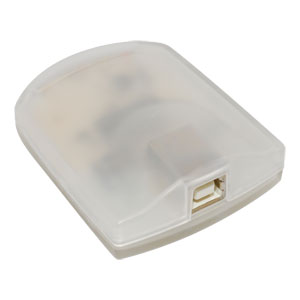- Connecting audio
- Audio PC
- Raspberry & Co
- All in Ones
- Bluetooth
- Chromecast
- Streaming audio player
- Music server
- USB Audio
- Real-time audio over IP
- FireWire DAC
- Multi-channel DAC
- NAS
- Remote control
- Vinyl rippers
- Acoustic materials
- Active crossover
- Active speakers
- Single driver speakers
- Invisible speakers
- Sound card
- Digital room correction
- Headphone
- Portable media players
USB Trouble shooting
Sometimes USB audio is hit by problems.
Hearing static, dropouts etc.
Data errors
Isochronous (continuous) transfer mode uses error checking but no retransmission in case of CRC (Cyclic Redundancy Check) errors. Electrical noise on USB signals causes CRC errors and thus data loss. This leads to audio signal distortions (clicks). This means that an USB audio device can work only if USB signal quality is good and no CRC errors occur. Most other USB device types (e.g. FLASH drive, printer) are based on bulk transfer mode which uses automatic retransmission in case of errors. These kind of devices are much more tolerant with respect to USB signal distortion. For this reason, it’s possible that a mouse, keyboard, FLASH drive, printer etc. works well on a given USB port using a given cable while an audio device does not work with the same port or cable.
Lindemann
Ports
Not all ports are created equal.
A famous phrase on many an audio forum.
Ports might have a routing close to a switching voltage regulator.
Poor cabling, bad connectors (front side port) might cause problems too.
Simply try different ports and check if it does something for you.
Sometimes sharing an internal hub with a mouse or a blue tooth device might be audible.
If you move the mouse you will hear scratches in the audio.
In Win you can use the Device Manager to find out if the USB hub is shared with another device.
A simple solution is to buy a PCI to USB card. As it is PCI it gets 1 exclusive interrupt. Use this one for USB audio only and the audio device can get 100% bandwidth.
Cables
Cables can cause problems too.
Bad connectors, frills like status LEDs, etc.
Best is to use USB certified cables.
With the advent of USB audio class 2 devices (High Speed = 480 Mb/s) cabling will become more critical.
dropouts
The DPC latency problem
Windows is not a real time operating system. All requests to the operating system are delivered on a best effort basis. There are no guarantees whatsoever that requests are delivered within a certain time frame, which are the characteristics of a real-time operating system. That is not a problem for most devices and tasks but this is bad news for audio applications (which are considered soft real-time) because they need to deliver data to the subsystem and the hardware in buffers several times per second. If one or more buffers miss their deadlines and are not delivered in time it has audible consequences which are recognized as dropouts, clicks and pops.
Source: Resplendence
DPC=Deferred Procedure Call
Although isochronous transfer reserves bandwidth on the USB hub, it has no control over what is happening upstream.
If a process in Kernel mode monopolizes the CPU a dropout in the audio will be the result.
Culprits are ill behaving WLAN or Ethernet drivers, anti-virus software, etc.
The Windows Resource Monitor or a tool like DPC Latency checker will help you to find out if you have this type of issues.
Tools to check your systems latency can be found here.
Power saving
Sometimes power saving modes can result in the audio to stutter.
This can happen when a laptop is powered by battery.
Choose a High Performance setting.
Sometimes you need to disable these settings in the BIOS.
Checking the USB input of a DAC
Often manufacturers are pretty unclear about the capabilities of the USB input of a DAC.
What bit depth, what sample rates are supported?
Is it adaptive or asynchronous synchronization?
When you connect a USB device it will report its properties to the PC (device enumeration).
A tool like Thesycon USB Descriptor Dumper will tell you everything about the USB receiver of your DAC.
AS Format Type 1 Descriptor:
0x18 bBitResolution (24 Bits/sample)
0x04 bSamFreqType (Discrete sampling frequencies)
0x00AC44 tSamFreq(1) (44100 Hz)
0x00BB80 tSamFreq(2) (48000 Hz)
0x015888 tSamFreq(3) (88200 Hz)
0x017700 tSamFreq(4) (96000 Hz)
Endpoint Descriptor (Audio):
Transfer Type: Isochronous-Transfer
Synchronization Type: Adaptive
Usage Type: Data
0x0240 wMaxPacketSize (576 Bytes)
Testing
USB ports can be tested with a loopback plug.

PassMark USB loopback plug $50,-
- Quickly check if a USB port is powered;
- Check that data can be sent and received from the port;
- Check USB errors rates and transmission speed (up to 480Mbits/sec) in Windows;
- Measure the level of recovered data (retransmitted frames);
- Verify that the system remains stable under long periods of load;
- Test that USB support in Windows or Linux is available;
- Test self powered USB hubs and PC ports function correctly;
- Check USB cabling;
- Concurrently check multiple USB ports at the same time;
- Benchmark your PC's USB ports & hubs; and
- Check if your PC ports are high speed 480Mbits/sec (USB 2.0), or full speed 12Mbits/sec (USB 1.x) via a LED
- USB audio dropouts on XP - Computer Audio Asylum
- A cheap, fast and effective way to circumvent USB IRQ issues - Computer Audio Asylum
- Crazy problem: USB port provides bad sound, but only at low CPU usage
- CYCLIC REDUNDANCY CHECKS IN USB - USB Implementers Forum

